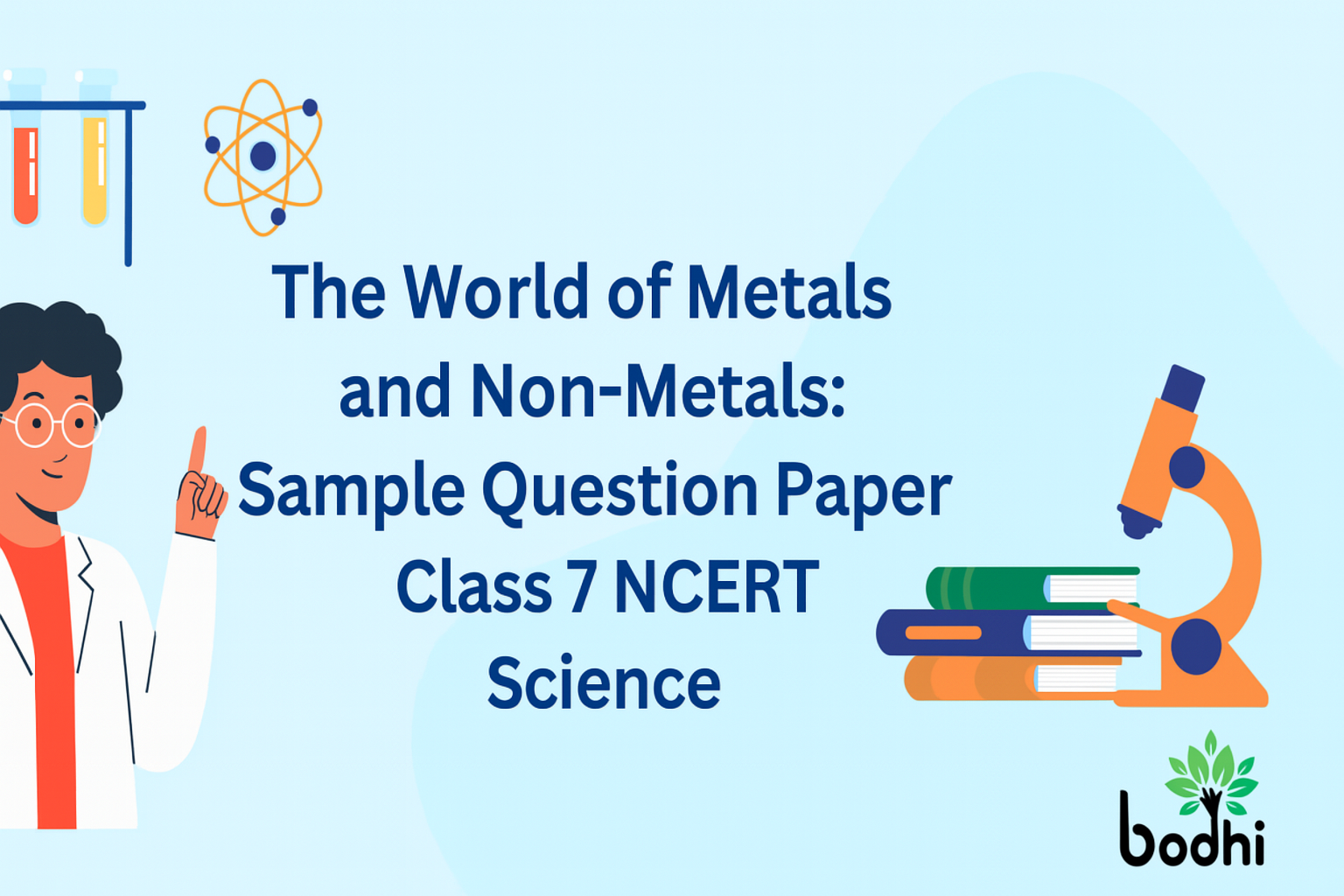Welcome to Bodhiclasses – your go-to destination for structured and high-quality science resources. We believe in empowering learners with thoughtfully curated materials to build a solid academic foundation. Below is a sample question paper for Class 7 Science Chapter 4 – The World of Metals and Non-Metals, complete with MCQs, one-mark, two-mark, and HOTS questions. Use it for practice, revision, or classroom assessment.

Sample Question Paper: The World of Metals and Non-Metals
Class: 7
Subject: Science
Chapter: 4 – The World of Metals and Non-Metals
Total Marks: 40
Time: 1 Hour

Section A: Multiple Choice Questions (1 × 10 = 10 marks)
Choose the correct option:
- Which of the following is the most ductile metal?
(a) Iron (b) Silver (c) Gold (d) Zinc - Which non-metal is essential for respiration?
(a) Nitrogen (b) Carbon (c) Oxygen (d) Sulfur - What is the property of a metal to be beaten into thin sheets?
(a) Sonority (b) Malleability (c) Ductility (d) Hardness - Which oxide is formed when magnesium reacts with oxygen?
(a) Sulfur oxide (b) Magnesium oxide (c) Nitric oxide (d) None - Which non-metal is used in water purification?
(a) Chlorine (b) Iodine (c) Phosphorus (d) Carbon - Which material is a poor conductor of electricity?
(a) Aluminium foil (b) Wood (c) Copper wire (d) Iron nail - Which metal is stored in kerosene due to its reactivity?
(a) Iron (b) Magnesium (c) Sodium (d) Aluminium - Which metal is most malleable?
(a) Zinc (b) Iron (c) Gold (d) Aluminium - What kind of oxide is formed by sulfur?
(a) Basic (b) Acidic (c) Neutral (d) Alkaline - Which property explains why a school bell is made of metal?
(a) Ductility (b) Sonority (c) Conductivity (d) Reactivity
Section B: One Mark Questions (1 × 10 = 10 marks)
- What is ductility?
- Name one metal that is liquid at room temperature.
- Why is zinc used for galvanisation?
- What is meant by corrosion?
- State one property of non-metals.
- Name the gas formed when a metal reacts with water.
- Which metal is used in making electrical wires?
- Name a non-metal used in antiseptics.
- What is the appearance of most metals?
- Define the term “sonorous”.
The World of Metals and Non-Metals
Section C: Two Mark Questions (2 × 5 = 10 marks)
- Differentiate between metals and non-metals based on conductivity.
- What happens when magnesium ribbon is burnt in air? Mention the nature of the product formed.
- Why is iron not used to make ornaments?
- Explain with example how the reactivity of a metal affects its storage.
- Give two reasons why copper is suitable for making cooking vessels.
Section D: Higher Order Thinking Skills (HOTS) (2 × 5 = 10 marks)
- Why does rusting only happen when iron is exposed to both air and water?
- Can sulfur be used to protect iron from rusting? Why or why not?
- A student uses a wooden spoon instead of a metal one in a science experiment involving heat. Explain why this is not effective.
- How does the property of malleability help in real-life applications of metals?
- Why do we use non-metal elements like nitrogen and carbon more in agriculture and biology?
Answer Key / Solution Sheet: The World of Metals and Non-Metals
Section A: MCQ Answers
- (c) Gold
- (c) Oxygen
- (b) Malleability
- (b) Magnesium oxide
- (a) Chlorine
- (b) Wood
- (c) Sodium
- (c) Gold
- (b) Acidic
- (b) Sonority
Section B: One Mark Answers
- The ability of a metal to be drawn into wires.
- Mercury
- To prevent iron from rusting.
- Gradual damage to metal due to moisture and air.
- Non-metals are poor conductors of electricity.
- Hydrogen gas
- Copper
- Iodine
- Lustrous or shiny
- The ability of metals to produce a ringing sound when struck.
Section C: Two Mark Answers
- Metals conduct electricity well; non-metals are poor conductors.
- It forms white magnesium oxide, which is basic in nature.
- Because it rusts and lacks lustre and malleability.
- Sodium is very reactive and must be stored in kerosene.
- Copper conducts heat well and does not rust easily.
Section D: HOTS Answers
- Both air and water are required for rusting; moisture accelerates the reaction with oxygen.
- No, sulfur is brittle and cannot form a protective coating like zinc.
- Wood is a poor conductor of heat; it won’t transfer heat effectively.
- It allows metals to be used in foils, sheets, and various shapes.
- Nitrogen helps plants grow; carbon is the basis of all life forms.


